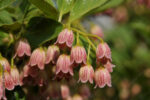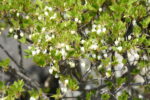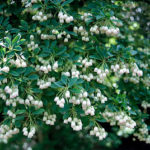This first appeared as “Spotlight on Ornamentals: An up and Coming Landscape Plant – Enkianthus” in the IR-4 Newsletter 47(1):9.
Plant Information
Enkianthus species naturally occur in southeast Asia and were introduced into England by botanist Charles Maries in the late 1800’s on a plant collection trip to Japan, China and Taiwan where he discovered 500 new plants. During this trip, Maries collected seeds and shipped them back to England where Veitch Nurseries evaluated plants for introduction into the plant trade.
 Enkianthus species range from deciduous low shrubs to small trees. At the smaller end, E. perulatus ‘Compacta’ grows to 2 feet, while E. campanulatus (redvein enkianthus) is a small tree topping out at 15 feet under warm temperate growing conditions. Enkianthus bloom in spring to early summer with white or red pendulous flowers on branches formed previous years. While most species have somewhat inconspicuous blooms at less than 1/2″, E. serrulatus bears ivory blooms from 1/2 – 3/4″ across and dangle from the bare branches like so many celestial bells. Fall color is variable from yellow to orange to bright red depending on species and cultivar.
Enkianthus species range from deciduous low shrubs to small trees. At the smaller end, E. perulatus ‘Compacta’ grows to 2 feet, while E. campanulatus (redvein enkianthus) is a small tree topping out at 15 feet under warm temperate growing conditions. Enkianthus bloom in spring to early summer with white or red pendulous flowers on branches formed previous years. While most species have somewhat inconspicuous blooms at less than 1/2″, E. serrulatus bears ivory blooms from 1/2 – 3/4″ across and dangle from the bare branches like so many celestial bells. Fall color is variable from yellow to orange to bright red depending on species and cultivar.
 Related to rhododendrons, azaleas and other members of the ericaceae plant family, enkianthus prefer moist acidic soils rich in organic matter and are hardy int USDA Hardiness Zones 4-7. Redvein enkianthus is fairly cold tolerant and can grow in Zone 4. Other species typically grow best is zones 5-7.
Related to rhododendrons, azaleas and other members of the ericaceae plant family, enkianthus prefer moist acidic soils rich in organic matter and are hardy int USDA Hardiness Zones 4-7. Redvein enkianthus is fairly cold tolerant and can grow in Zone 4. Other species typically grow best is zones 5-7.
Main Disease and Pest Problems
Generally, enkianthus are untroubled by pests and diseases, but there are reports of cottony cushion scale, mulberry borer, lacebug, and Phytophthora cinnamomi. Growing outside the optimal acidic soil range can cause chlorotic leaves.
IR-4 Research
 Although enkianthus species and cultivars have bee planted in the United States for decades, these plants have not been commonly available through garden centers. Due to their attractive landscape qualities, more enkianthus will be produced over time, but growers have little information on use of herbicides. Starting in 2016, IR-4 has begun screening over the top applications and pre-emergent herbicides to determine whether early applications as plants are breaking dormancy will cause unacceptable injury.
Although enkianthus species and cultivars have bee planted in the United States for decades, these plants have not been commonly available through garden centers. Due to their attractive landscape qualities, more enkianthus will be produced over time, but growers have little information on use of herbicides. Starting in 2016, IR-4 has begun screening over the top applications and pre-emergent herbicides to determine whether early applications as plants are breaking dormancy will cause unacceptable injury.
Enkianthus Growing Tips From The Telegraph
Gardeners on acid or neutral soil can grow successfully a number of shrubs that display both attractive flowers in spring and superb autumn color. Enkianthus has much to offer anyone gardening on soil with a pH below 6.5. Enkianthus campanlatus is the most commonly available and can be found in large garden centers as well as tree and shrub nurseries. It has a spreading habit, with branches in whorls, and eventually grows to about 10ft high. The pendulous, bell shaped flowers appear in May and June, clustered in a raceme that numbers up to 15; these are, individually, 1/2″ long and have a ground color of cream. with pale pick veins. The mouths of the flowers are indented. The leaves are clustered at the end of twigs, elliptic in shape, up to 2″ long and 1″ wide, with hairs on the veins. In the autumn, these leaves turn to fiery shades of red and orange.
Growing Tips
Enkianthus are not a problem to grown, provided they are planted in an acid of neutral soil. They are happiest in partial shade, but will grow in full sun, and need a soil that holds some moisture in summer. They should be placed in a sheltered stop, not only because they do not appreciate cold winds, but also because this enables the leaves to last as long as possible in autumn – which is desirable
Plant in autumn or spring into a humus-rich soil, then mulch well, preferably with home-made leafmould. Enkianthus do not need pruning, unless they become misshapen or outgrow their place, in which case they should be cut back in early spring. These low-maintenance shrubs are not bothered much by pest or disease. Propagation can be achieved by layering, or by semi-ripe cutting in the summer.
Good Companions
Enkianthus are often seen in long-established woodland gardens, but any garden with an acid soil will benefit from one of these. They should be placed where the autumn color can be admired, even from a distance. Alternatively, these shrubs can be grown in big pots in an ericaceous compost. They naturally associate with pieris, which have similar flowers, as well as rhododendron, especially those with pink, white or crimson flowers.
Their deciduous nature can be a relief among so many acid-loving evergreen shrubs such as camellias and rhododendrons, bringing welcome variety when they come into leaf in spring. If growing enkianthus as a specimen shrub in sun, it can be associated successfully with late-flowering chysanthemums and asters such as A. x frikartii, and the low, blue flowering shrub Ceratostigma willmottianum.
In semi-shade, it looks terrific with the purple-blue Acontium carmichaelii. Its deciduous nature means that spring bulbs, such as Crocus tommasinianus will grow around it, as will the autumn crocus, C. speciosis.


